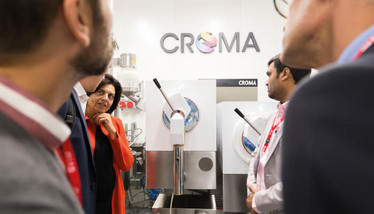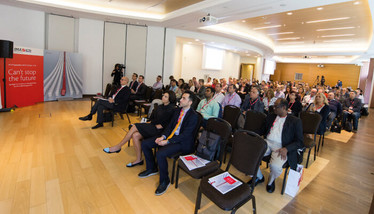
A Circular Debate
Are continuous manufacturing technologies proving their worth in practice?

This article is part of our special focus on "traditional" pharma: The Small Molecule Manufacturer (read more here). You can find more articles from The Small Manufacturer here.

Given the oft-discussed advantages of continuous manufacturing in meeting pharma’s demands for rapid development, reduced costs, and increased manufacturing flexibility, why does batch manufacturing still dominate the market? And does 2020 mark the start of the continuous revolution?
Bringing together professionals from across the pharmaceutical industry, IMA Active’s ”Can’t Stop the Future” event provided an opportunity to discuss the practical hurdles involved in the adoption of continuous manufacturing and how the regulatory landscape is evolving to help support companies ready to take the leap. According to Guia Bertuzzi, Product Manager at IMA SpA, the large turnout was indicative of the growing interest in continuous manufacturing. And with over 200 attendees with varied interests, there was much to be discussed.
A regulatory perspective
Regulatory guidelines have typically focused on implementing management-based guidelines rather than performance-based ones. Consequently, most guidelines are prospective, aiming to help companies improve their current processes, products and services, and reduce the possibility of defects (Sigma Six). Many in the industry favor a shift to performance-based guidelines (which are retrospective, reflecting on past failures in order to improve future outcomes), but regulators are understandably cautious.
Moheb M. Nasr, Principal at Nasr Pharma Consulting, gave his take on the current regulatory outlook. Although there is no specific guideline for continuous manufacturing, he believes that ICH Q8,9, and 10 can accommodate companies’ drug development and risk-based regulatory needs. He also outlined what the industry could expect from ICH Q12, a guideline that addresses the technical and regulatory aspects of reporting post-approval changes in manufacturing, classifying process parameters as critical, key and non-key. The draft was released at the end of 2017, and caused some consternation amongst industry experts because its management-based approach meant that parameters could be classified as critical or key in one context but non-key in another, adding yet more layers of complexity.
Because continuous manufacturing processes have considerably more engineering details than batch processes, Nasr reported that some within industry fear post-approval changes could become a major challenge. If companies were to update or improve their continuous processes, would production have to be halted until approval of the new process, risking considerable downtime? Nasr explained that this is unlikely to be the case – the ICH committee is looking at a system in which a subset of information within a submission (called “established conditions”) must remain unchanged upon resubmission. Only if changes are made to these established conditions would companies expect to face regulatory appraisal. The rest of the information is classed as “supportive” and could be subject to change without further regulatory involvement. “This proposed idea is revolutionary in my opinion,” Nasr said. “But it will need to be tested.”

In practice
Both Nasr and Bernhardt Trout (Raymond F. Baddour, ScD, (1949) Professor of Chemical Engineering and Director at the Novartis-MIT Center for Continuous Manufacturing), commented that despite the changing regulatory landscape, continuous manufacturing is already changing the way the industry is producing drugs. With a handful of drugs now approved using continuous manufacturing (Vertex’s Orkambi and Symdeko; Johnson & Johnson’s Prezista; Eli Lilly’s Verzenio and Pfizer’s Daurismo) in the US for example, the industry has a number of success stories and has learned valuable lessons. Examples of success were relayed by several of the speakers at the event who highlighted their companies’ journeys with continuous manufacturing processes. Giustino Di Pretoro, Associate Director at Janssen Pharmaceutica, a Johnson & Johnson company, outlined how the company achieved regulatory approval for Prezista, an antiretroviral drug used to treat and prevent HIV/AIDS, using continuous manufacturing. “In 2008, in collaboration with a group of universities, we decided to conceptualize the idea of continuous manufacturing for oral drug products with real industrial applications,” he told the audience. By 2013, the company had designed, implemented and qualified their first self-assembled line for the continuous manufacture of Prezista. Previously, the product was manufactured by Janssen using batch manufacturing processes at a high volume. In 2015, the product was recommended for expedited approval and by April of the same year the drug was approved. Though the company encountered difficulties in trying to bring a drug product to market using continuous manufacturing, di Pretoro said that it “was certainly rewarding”. By adopting continuous manufacturing, Janssen was able to reduce the manufacturing cycle time for Prezista by 70 percent (from 13 days to just over 25 hours), lower their footprint and carry out in-line and on-line quality measurements, which helped improve the overall quality of their drug product.
Other speakers including Guia Bertuzzi and Salvatore Mascia, Founder and President of CONTINUUS Pharmaceuticals (a Novartis-MIT spinout which partnered with IMA in 2013), also discussed the value of continuous manufacturing for reducing lead times and the challenges companies encounter when they opt for alternatives to advanced manufacturing systems. “The residence time for our continuous process is roughly 30 hours,” explained Mascia. “We recently began a project with a company who claims that the lead time for making one of their APIs is two years. Continuous manufacturing could, therefore, have a significant impact on their manufacturing capabilities.”
Better by design
Though many of the speakers stressed the time-saving nature of continuous manufacturing, the modular and compact design of continuous systems was also said to contribute to its value. “The benefit of a modular design is that you can go from drug A to drug B in a very short time in a way that is applicable to many APIs with different physicochemical properties,” Mascia explained.
Bertuzzi went on to further explain how the modular and compact design of continuous systems, such as continuous tablet coating equipment, allowed for their easy reconfiguration for the requirements of different drug products -- a sentiment echoed by Frank Streil, Director Technical and Scientific Affairs at TEVA, who presented a case study outlining how the company implemented and validated continuous manufacturing for the direct compression of tablets.
Mascia also described how process analytical technology (PAT) systems can be integrated at various stages of the manufacturing process to give companies meaningful data on reaction progress and allow for real-time monitoring of critical performance attributes in large scale processes. PAT has been defined by the FDA as a framework for encouraging and improving pharmaceutical innovation and relies on critical process parameters (CPP). CONTINUUS Pharmaceuticals currently relies on ReactIR, FBRM, n-IR, particle size analyzers and Raman to measure CPP.

Room for growth
But while the presentations delivered were testimonies to the benefits of implementing continuous systems, both Nasr and Trout alluded to the fact that there is still room for growth before these technologies can cement themselves in the industry infrastructure. Pharmacopoeias need to play a more active role in defining continuous manufacturing and its requirements to help dispel some of the worry felt by the industry. “International pharmacopoeias need to include general definitions of what continuous manufacturing is and explicitly state, in additional chapters, the requirements for the manufacture of excipients as their manufacturers may have to take into account aspects of manufacture unique to this type of product,” Nasr argued. Some excipient associations like the International Pharmaceutical Excipient Council (IPEC) have been active in trying to accelerate the acceptance of excipient monographs for coprocessed, high-functionality excipients, but Nasr admitted that more work needed to be done to improve this aspect of industry. “Pharmacopoeias also need to be better prepared for additional real-time release testing as the traditional stop-start approach might not be enough to address the complexities of continuous manufacturing.”
He expressed that, in his opinion, regulatory filings should not include in-depth engineering details as he feels that it would spell “the end of continuous manufacturing” as there are far too many aspects of design to be considered. He suggested that it would be better to include such details in supporting information instead.
Another consideration raised by an audience member was the impact of continuous manufacturing technologies on the production of biologics. While the companies represented at the event were mainly focused on small molecules, many were interested in using their experiences to help continuous production to be rolled out to the biologic space.
As conversations about continuous manufacturing continue and the various elements of the pharmaceutical industry begin to work more collaboratively, a clearer picture of how such processes will work in practice should begin to form.
After finishing my degree, I envisioned a career in science communications. However, life took an unexpected turn and I ended up teaching abroad. Though the experience was amazing and I learned a great deal from it, I jumped at the opportunity to work for Texere. I'm excited to see where this new journey takes me!



















